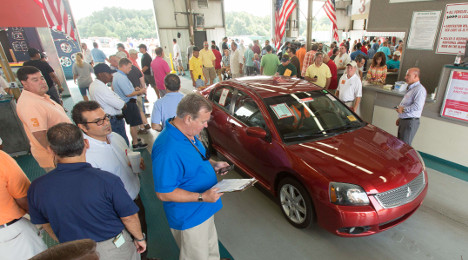What to look for in commercial consignment this year

Action from Manheim North Carolina in 2014. Photo by Jonathan Fredin.
Much like the dealer consignment side of the auction lane, you can expect commercial consignment to rise this year and next.
According to a National Auto Auction Association forecast in Manheim’s 2016 Used Car Market Report, the drivers of the expected gains in commercial consignment are the spikes from prior years in new-car leases, outstanding finance contracts and business fleet purchases.
These would follow the year of growth in commercial consignment in 2015.
In the company's latest earnings conference call, executives with KAR Auction Services gave some color on how commercial consignment has trended for their ADESA subsidiary.
Commercial consignment at company’s physical auction locations was up 3 percent in the fourth quarter, a softer rate of increase than the 13-percent spike ADESA notched for the full year.
But don’t read too much into that.
“The lower commercial volume increase in the fourth quarter is not due to a lack of supply . We had a significant increase in the number of commercial cars on the ground at year-end. The consignors spent the ancillary services dollars on these vehicles, and they are ready to sell early in 2016,” said KAR chief financial officer Eric Loughmiller.
When prompted by a commercial consignment question during the Q&A later in the call, Loughmiller pointed out that there was a double-digit jump in the third quarter that preceded the 3-pecent dip and followed a strong second quarter and a “little weaker” first.
“It’s really the consignors, and it's predominantly going to be the OEMs and the captive finance companies, you had the cars coming back. They were selling aggressively on the upstream or the private-label site, which was up 32 percent for the quarter. But as it got to the physical auction, the cars are on the ground,” Loughmiller added. “They did the work to improve the quality of the vehicle, which is the ancillary services. And while we don't discuss a specific inventory number at ADESA, those cars are building up and we're seeing, as if you visit one of our sites, you'll see a lot of cars on the ground even right now.”
KAR chairman and chief executive officer Jim Hallett followed by saying that “there's the impact of the holidays that could be slowing down, pushing these cars to the channel.”
He also pointed out that less rapid increase in Q4 doesn’t indicate a trend, saying that, “I believe there's an anomaly that took place in the quarter.”
Overall, a couple of side trends to watch in commercial consignment:
- Off-rental: Manheim’s report indicates that the overall wholesale market took in about 1.66 million off-rental units last year (around 47 percent ended up being sold at an NAAA-member auction), and that should climb to about 1.8 million this year and stay there for a while.
- Off-lease: Volume here has been on rise since 2012, and should stay that way. Manheim Consulting data indicates there were 2.5 million off-lease units in 2015. That is projected to climb past 3 million in 2016, past 3.5 million in 2017 and approach 4 million in 2018
That said, Manheim’s report points out that many captives are using various sales platforms and technologies to offer off-lease units to their own dealer body, particularly the grounding dealer, before the cars head to action.
“As off-lease volumes grow in coming years, it is likely that the share of off-lease units bought by the grounding dealer will decline, but probably not by much since the captive lessor will still put priority on that first possible sale—and offer an attractive price to achieve it,” Cox Automotive chief economist Tom Webb, who authored the report, wrote in the analysis.

 View The Latest Edition
View The Latest Edition

